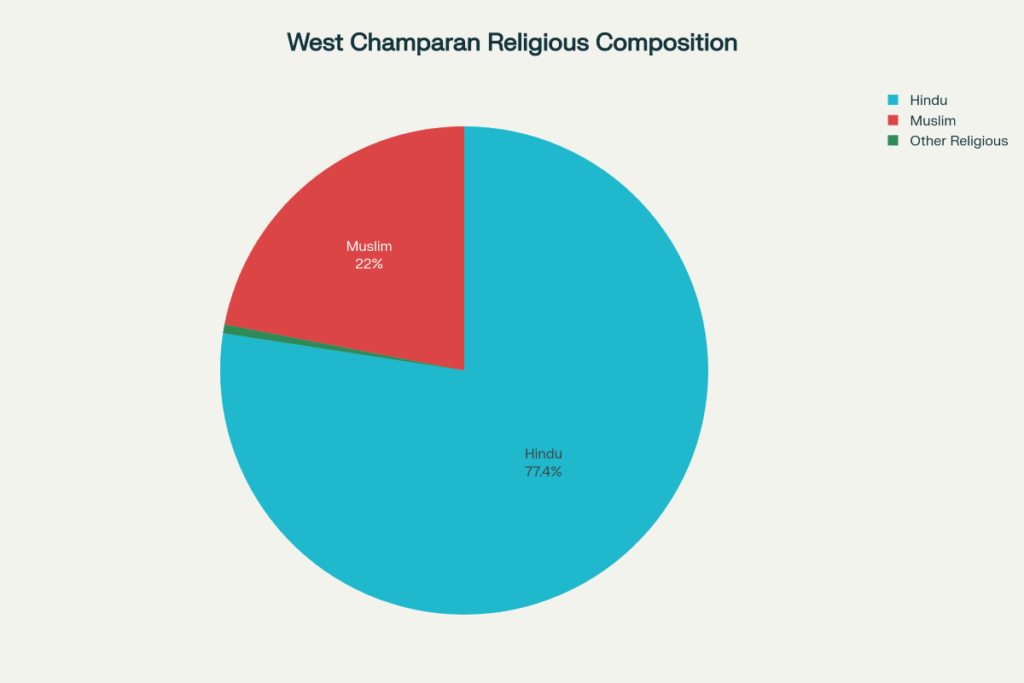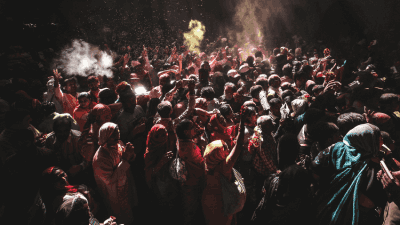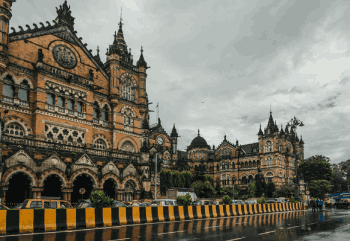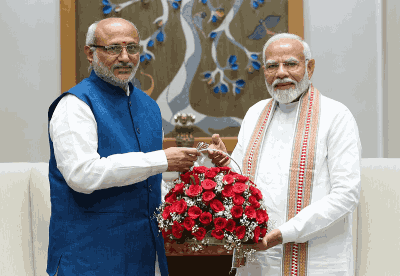District Overview and Population Dynamics
West Champaran stands as Bihar’s largest district by area (5,228 sq km) and ranks ninth in population with approximately 5.25 million residents as of 2025 projections. The district exhibits a predominantly rural character, with 90.01% of the population residing in rural areas while only 9.99% lives in urban centers. This rural dominance significantly shapes the electoral discourse, where agricultural issues, land rights, and traditional social hierarchies remain paramount concerns for voters.
The population density of 753 persons per square kilometer is notably lower than Bihar’s state average of 1,106, reflecting the district’s frontier character along the Indo-Nepal border. The sex ratio of 909 females per 1,000 males is slightly below the state average, while the literacy rate of 55.7% lags behind Bihar’s overall rate of 61.8%. These demographic indicators reveal persistent developmental challenges that political parties must address in their electoral strategies.

West Champaran District: Demographic Composition by Caste and Religion (Census 2011)
Population & Growth
- Estimated population (2025): ~5.25 million (52.55 lakh)
- Population density: 753 persons/sq.km
- Rural-urban split: Over 90% rural, under 10% urban
- Sex ratio: 909 females per 1,000 males
- Literacy rate: 55.7% (lower among women)
Scheduled Castes (SC), Scheduled Tribes (ST), and Minority Dynamics
| Constituency | SC % | ST % | Muslim % | Dominant Groups |
|---|---|---|---|---|
| Valmiki Nagar (LS) | 14.8% | 9.2% | 20.1% | SC (Chamar), ST (Tharu), Muslims |
| Paschim Champaran (LS) | 11.4% | 0.7% | 22.7% | Yadav, Brahmin, Bhumihar, Muslims |
Caste Dominance & Voting Influence
- Valmiki Nagar: Significant Tharu and other ST population; large SC base (Chamar). Also has a substantial Muslim electorate, key for coalition-building. Brahmins and Mahto (Kushwaha) also have pockets of influence. Caste solidarity strongly shapes outcomes, with political parties often fielding candidates from numerically-strong groups.
- Paschim Champaran: OBC groups (especially Yadav and Kushwaha) are numerous; Brahmins and Bhumihar have historical patronage status, but their influence has moderated somewhat due to demographic and political changes. Muslims form a crucial block in several assembly segments.
Electoral Structure & Trends
- Both Lok Sabha seats encompass six assembly segments, most with a rural, agrarian character and strong linkage to local caste panchayats.
- Political alliances (e.g., NDA vs. INDIA bloc) usually try to pool OBC, SC, EBC, and minority votes to cross the 30% winning threshold, given highly fragmented voter bases.
- Historical voting shows voter turnout around 62%, with urban areas slightly behind rural segments.
Socio-economic Indicators
- Literacy: Literacy gaps are more stark in rural areas and among women (male literacy 65.6%, female literacy 44.7%).
- Development: Agriculture is the dominant occupation; sugarcane farming and forest rights (especially for Tharu tribals) are major local issues, along with migration and a lack of industrial growth.
- Caste politics: Local alliances and micro-level caste negotiations (especially among OBCs and EBCs) heavily impact assembly-level results. Some turbulence exists due to shifting support among Dalits and Most Backward Classes, particularly when national parties change their candidate mix or messaging.
Caste Composition and Social Stratification
The caste demographics of West Champaran present a complex tapestry that defines electoral politics in the region. Scheduled Castes constitute 14.1% of the population (553,944 individuals), while Scheduled Tribes represent 6.4% (250,046 people). Among the ST population, the Tharu community forms the largest tribal group, concentrated primarily in areas near the Nepal border, particularly around Valmiki Nagar constituency.
The Other Backward Classes (OBCs) represent a significant portion of the electorate, with Yadavs forming approximately 14.27% of the OBC population statewide, making them a crucial voting bloc. Kushwahas (Koeris) also maintain substantial influence, particularly in constituencies like Lauriya and Chanpatia. The forward castes, including Brahmins (approximately 3.65% statewide), Rajputs (3.45%), and Bhumihars (2.86%), though numerically smaller, continue to wield considerable economic and social influence.
Religious Demographics and Electoral Implications
The religious composition adds another layer of complexity to the electoral matrix. Muslims constitute 21.98% of the district’s population (865,090 individuals), significantly higher than the state average of 16.9%. This substantial Muslim presence creates distinct electoral dynamics, particularly in constituencies like Narkatiaganj, where Muslims comprise over 30% of the electorate, and Narkatiya, where they form a significant minority.
Hindus represent 77.44% of the population (3,047,427 individuals), with Christians forming a small but notable minority at 0.22%. The religious demographics significantly influence alliance politics, with parties carefully calibrating their candidate selection and campaign messaging to appeal to these diverse communities.
Assembly Constituencies: Detailed Electoral Analysis

West Champaran District: Current Political Party Control (2020 Assembly Results)
Valmiki Nagar Lok Sabha Constituency
The Valmiki Nagar parliamentary seat encompasses six assembly segments, each presenting unique demographic and political characteristics that shape electoral outcomes.
Valmiki Nagar Assembly Constituency serves as the namesake seat with a general category classification. The constituency exhibits a mixed demographic profile with significant OBC and ST populations. The Tharu tribal community maintains substantial influence here, leveraging their indigenous status and environmental concerns related to forest rights and conservation policies. The JD(U) currently holds this seat, reflecting the party’s appeal among tribal and OBC voters through targeted welfare schemes and political representation.
Ramnagar (SC) Assembly Constituency is reserved for Scheduled Castes, making Dalit political mobilization central to electoral success. The constituency’s SC population of approximately 15.15% creates a competitive environment where parties must demonstrate genuine commitment to Dalit welfare and empowerment. The BJP’s current control of this reserved seat indicates successful outreach to Dalit communities through welfare schemes and strategic candidate selection.
Narkatiaganj Assembly Constituency presents perhaps the most complex demographic challenge within the Valmiki Nagar parliamentary seat. With Muslims comprising over 30% of the electorate and SCs forming 15.15%, successful candidates must build broad coalitions transcending religious and caste boundaries. The BJP’s consistent victories here, despite the substantial Muslim population, demonstrate the party’s ability to mobilize non-Muslim votes effectively while benefiting from opposition vote fragmentation.
Bagaha Assembly Constituency carries historical significance as a SC-reserved seat with notable ST presence (3.94%) and Muslim population (16.10%). The constituency’s proximity to the Nepal border creates unique cross-border cultural and economic ties, particularly with the Tharu community. The BJP’s recent dominance represents a significant shift from the historical Congress stronghold, indicating changing political preferences among Dalit voters.
Lauriya Assembly Constituency exhibits a predominantly OBC-Hindu demographic profile with traditional agricultural interests dominating local politics. The BJP’s control reflects the party’s successful cultivation of OBC support through development promises and cultural messaging. The constituency’s rural character makes agricultural policies and rural development schemes crucial electoral issues.
Sikta Assembly Constituency stands apart as the only constituency currently held by the CPI(M-L)L, representing the left’s remaining influence in Bihar politics. The constituency features tribal pockets and has historically been receptive to leftist ideology focusing on land rights, labor issues, and social justice. This represents a potential vulnerability for the NDA in an otherwise dominated region.
Paschim Champaran Lok Sabha Constituency
The Paschim Champaran parliamentary seat encompasses six assembly segments with distinct demographic and political characteristics.
Nautan Assembly Constituency maintains a general category status with a predominantly OBC demographic profile. The BJP’s control reflects successful mobilization of OBC voters through welfare schemes and development initiatives. The constituency’s rural agricultural character makes farming-related policies central to electoral discourse.
Chanpatia Assembly Constituency represents the JD(U)’s organizational strength in rural areas with its focus on agricultural and rural development. The constituency has witnessed innovative initiatives like the “Startup Zone” program for returning migrant workers, demonstrating local governmental creativity in addressing employment challenges. This rural-agricultural focus aligns well with JD(U)’s traditional support base.
Bettiah Assembly Constituency serves as the district headquarters with the highest urban concentration in West Champaran. The BJP’s dominance here reflects the party’s appeal among urban and semi-urban voters through development promises and administrative efficiency. As the commercial and administrative hub, Bettiah’s electoral preferences often influence surrounding rural constituencies.
Raxaul Assembly Constituency enjoys strategic importance due to its border location with Nepal, creating unique trade and commerce opportunities. The BJP’s control benefits from the party’s focus on border infrastructure development and cross-border trade facilitation. The constituency’s mixed population engages in both agriculture and border commerce.
Sugauli Assembly Constituency currently represents RJD influence with its mixed caste demographic profile. The constituency’s opposition status within an otherwise NDA-dominated region highlights localized political dynamics where personality-driven politics and specific caste equations override broader alliance preferences.
Narkatiya Assembly Constituency completes the Paschim Champaran seat with significant Muslim presence and RJD control. The constituency demonstrates the RJD’s continued appeal among Muslim voters and certain OBC segments, representing a crucial opposition stronghold that could influence broader electoral calculations.
Current Political Alignment and Electoral Trends
The 2020 assembly election results reveal NDA dominance across West Champaran, with the alliance controlling 10 out of 12 constituencies.
| Lok Sabha Seat | Assembly Constituency | Reservation Status | Current Party (2020) | Key Demographics | Political Trend |
|---|---|---|---|---|---|
| Valmiki Nagar | Valmiki Nagar | General | JD(U) | Mixed OBC-ST | NDA Strong |
| Valmiki Nagar | Ramnagar (SC) | SC Reserved | BJP | SC dominated | NDA Strong |
| Valmiki Nagar | Narkatiaganj | General | BJP | Muslim 30%+ | NDA Strong |
| Valmiki Nagar | Bagaha | General | BJP | SC-ST significant | NDA Strong |
| Valmiki Nagar | Lauriya | General | BJP | OBC-Hindu | NDA Strong |
| Valmiki Nagar | Sikta | General | CPI(M-L)L | Tribal pockets | Left/Opposition |
| Paschim Champaran | Nautan | General | BJP | OBC-General | NDA Strong |
| Paschim Champaran | Chanpatia | General | JD(U) | Rural-Agricultural | NDA Strong |
| Paschim Champaran | Bettiah | General | BJP | Urban-Commercial | NDA Strong |
| Paschim Champaran | Raxaul | General | BJP | Border trade | NDA Strong |
| Paschim Champaran | Sugauli | General | RJD | Mixed caste | Opposition |
| Paschim Champaran | Narkatiya | General | RJD | Muslim significant | Opposition |
The BJP holds 8 seats, demonstrating the party’s organizational strength and electoral appeal, while JD(U) controls 2 seats, reflecting its role as the senior alliance partner. The opposition holds only 2 constituencies through RJD, with the CPI(M-L)L holding 1 seat.
This political alignment reflects several underlying trends. The NDA’s success stems from effective welfare delivery, particularly schemes targeting women, farmers, and marginalized communities. The alliance has also benefited from superior organizational coordination between BJP and JD(U), avoiding the candidate conflicts that often plague opposition alliances.
The opposition’s limited presence highlights the challenges facing the RJD-Congress alliance in this region. Despite significant Muslim and Yadav populations that traditionally support these parties, the opposition has struggled with organizational weakness, candidate selection issues, and internal conflicts that have hindered effective electoral mobilization.
Emerging Political Dynamics for 2025
The 2025 assembly elections will unfold against a backdrop of significant political changes and emerging challenges that could reshape West Champaran’s electoral landscape.
Jan Suraaj Party Impact
Prashant Kishor’s Jan Suraaj Party represents perhaps the most significant new variable in Bihar’s electoral equation. Having launched his political journey from West Champaran with a padyatra beginning at Gandhi Ashram, Bhitiharwa, Kishor has intimate knowledge of local issues and grievances. The party’s focus on governance, education, and youth employment could resonate strongly in a region plagued by outmigration and limited economic opportunities.
Jan Suraaj’s potential impact appears most significant among educated youth and urban middle-class voters who feel disillusioned with traditional caste-based politics. The party’s emphasis on merit-based governance and development-focused politics could attract voters seeking alternatives to established political formations.
However, the party faces significant challenges in penetrating the deeply entrenched caste-based vote banks that define Bihar politics. Kishor’s acknowledgment that his party might function as a “vote-cutter” suggests realistic expectations about immediate electoral success while building for long-term political transformation.
Caste Census Implications
The 2023 Bihar Caste Census has provided empirical validation for caste-based political strategies while potentially reshaping electoral calculations. The census revealed that EBCs constitute 36.01% of Bihar’s population, OBCs 27.12%, SCs 19.65%, forward castes 15.52%, and STs 1.68%.
For West Champaran, these findings reinforce the importance of OBC coalition-building while highlighting the electoral potential of EBC mobilization. Political parties are likely to adjust their candidate selection and campaign strategies to reflect these demographic realities, potentially leading to more nuanced caste-based appeals.
Youth and Migration Concerns
Youth unemployment and large-scale outmigration represent critical issues that could influence electoral outcomes. With approximately 56% of Bihar’s population under 35 years, young voters’ preferences will significantly impact electoral results. The failure to create adequate employment opportunities has forced thousands of young people to migrate to states like Punjab, Delhi, and Maharashtra for work.
Political parties will need to present credible solutions for job creation, skill development, and industrial growth to appeal to these voters. Traditional welfare schemes and caste-based appeals may prove insufficient for a generation seeking economic opportunities and social mobility.
Women Voters and Social Issues
Women constitute approximately 47% of the electorate and have shown distinct voting patterns in recent elections. The prohibition policy, women’s safety concerns, and access to education and healthcare for girls represent crucial issues for female voters. The NDA’s welfare schemes targeting women, including financial assistance and healthcare programs, have contributed to strong female support for the alliance.
Opposition parties will need to articulate clear alternatives on women’s issues to challenge NDA dominance among female voters. The Jan Suraaj Party’s education-focused agenda could potentially appeal to women concerned about their children’s future prospects.
Key Electoral Issues and Campaign Themes
Economic Development and Employment
Industrial development and employment generation will likely dominate electoral discourse. West Champaran’s primarily agricultural economy has struggled to provide adequate livelihood opportunities for its growing population. The sugar industry and food processing represent potential growth areas that candidates will likely emphasize.
The border trade with Nepal offers additional economic opportunities that politically astute candidates could leverage. Infrastructure development, including road connectivity, railway expansion, and border facilities improvement, will feature prominently in campaign promises.
Agricultural Concerns and Land Rights
Agricultural distress remains a persistent concern in this predominantly rural district. Issues include inadequate irrigation facilities, crop insurance problems, market access difficulties, and land ownership disputes. The Sugarcane farmers’ concerns regarding payment delays and fair pricing will likely influence electoral outcomes in relevant constituencies.
For the Tharu tribal community, forest rights and land ownership represent existential concerns that could determine their electoral preferences. Political parties’ positions on these issues will significantly influence tribal voting patterns.
Infrastructure and Social Services
Educational infrastructure, particularly the quality of government schools and colleges, represents a critical concern for families seeking upward mobility. The healthcare system’s inadequacies, especially in rural areas, create opportunities for political parties promising substantial improvements.
Road connectivity, electricity supply, and water availability remain fundamental infrastructure challenges that resonate with all voter segments. The digital connectivity and mobile network coverage have become increasingly important, especially for younger voters.
Social Justice and Caste-Based Issues
Dalit rights and tribal welfare will continue to influence electoral calculations, particularly in reserved constituencies. The implementation of reservation policies in education and employment, along with protection from caste-based discrimination, remain crucial concerns for marginalized communities.
The Muslim minority’s security concerns and equal access to government schemes will influence their electoral choices. Political parties’ track records on communal harmony and minority welfare will be scrutinized by these voters.
Conclusion: A Pivotal Electoral Battleground
West Champaran district represents a fascinating microcosm of Bihar’s complex political dynamics, where traditional caste equations intersect with modern developmental aspirations, creating a multifaceted electoral battleground for the 2025 assembly elections. The district’s demographic composition—with significant SC (14.1%), ST (6.4%), and Muslim (22%) populations alongside a diverse OBC presence—ensures that successful political strategies must transcend simple caste-based appeals to build broader coalitions.
The current NDA dominance reflects effective governance delivery and organizational coordination, yet emerging challenges including youth unemployment, agricultural distress, and changing voter aspirations create opportunities for political realignment. The entry of new players like Jan Suraaj adds uncertainty to traditional calculations while potentially catalyzing broader political transformation.
Ultimately, the 2025 elections in West Champaran will likely be determined by parties’ abilities to balance traditional caste-based mobilization with credible development promises, effectively manage alliance dynamics, and respond to the legitimate aspirations of a young and increasingly connected electorate. The results will not only shape local governance but also provide crucial insights into Bihar’s evolving political trajectory and the enduring relevance of caste-based politics in contemporary Indian democracy.
The electoral outcomes will test whether Bihar’s political system can evolve beyond traditional identity-based mobilization toward more issue-driven democratic competition, or whether entrenched social hierarchies and caste-based voting patterns will continue to define political success. As such, West Champaran’s 2025 assembly elections represent more than a local political contest—they constitute a crucial experiment in democratic transformation within India’s most politically significant state.








